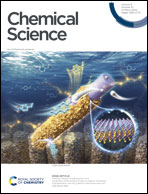Rapid, high-capacity adsorption of iodine from aqueous environments with amide functionalized covalent organic frameworks†
Abstract
The uses and production of radionuclides in nuclear energy production and medical therapy are becoming more significant in today's world. While these applications have many benefits, they can produce harmful pollutants, such as radioactive iodine, that need to be sequestered. Effective capture and storage of radioactive iodine waste remains a major challenge for nuclear energy generation and nuclear medicine. Here we report the highly efficient capture of iodine in a series of mesoporous, two-dimensional (2D) covalent organic frameworks, called COFamides, which contain amide sidechains in their pores. COFamides are capable of rapidly removing iodine from aqueous solution at concentrations as low as 50 ppm, with total capacities greater than 650 wt%. In order to explain the high affinity of the COFamide series for iodine and iodide species in water, we performed a computational analysis of the interactions between the COFamide framework and iodine guests. These studies suggest that the origin of the large iodine capacity in these materials can be explained by the presence of multiple, cooperative, non-covalent interactions between the framework and both iodine, and iodide species.



 Please wait while we load your content...
Please wait while we load your content...